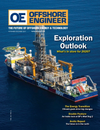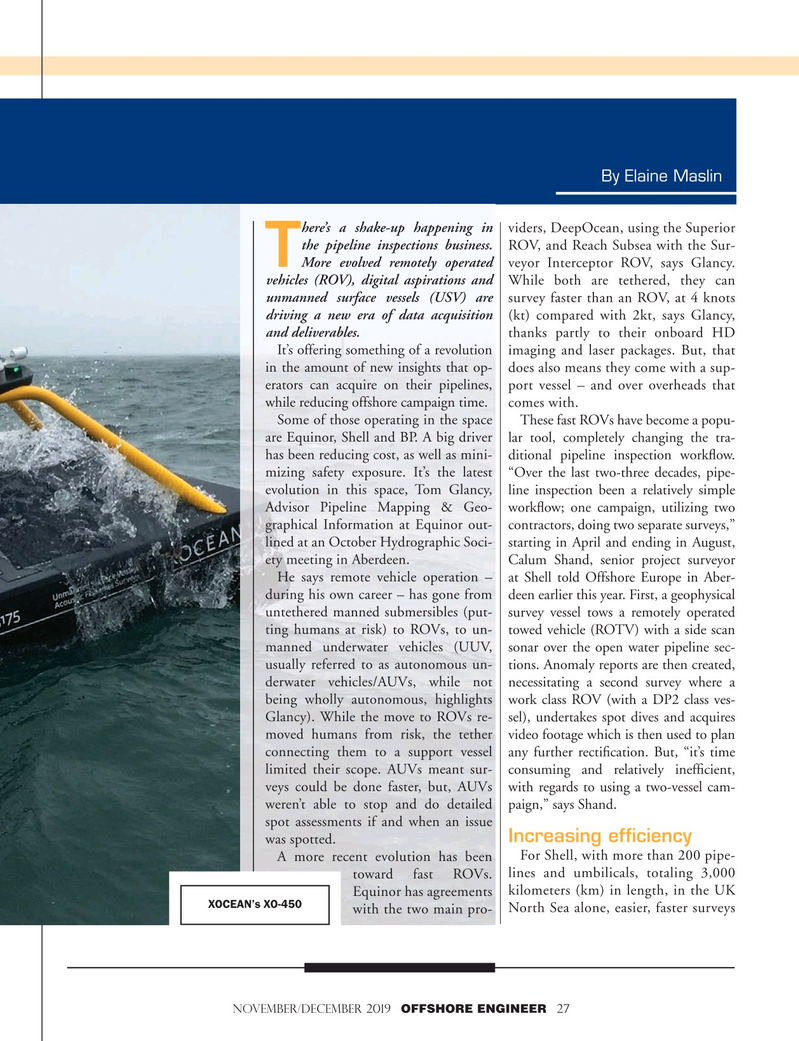
Page 27: of Offshore Engineer Magazine (Nov/Dec 2019)
Exploration Outlook
Read this page in Pdf, Flash or Html5 edition of Nov/Dec 2019 Offshore Engineer Magazine
By Elaine Maslin here’s a shake-up happening in viders, DeepOcean, using the Superior the pipeline inspections business. ROV, and Reach Subsea with the Sur-
T
More evolved remotely operated veyor Interceptor ROV, says Glancy. vehicles (ROV), digital aspirations and While both are tethered, they can unmanned surface vessels (USV) are survey faster than an ROV, at 4 knots driving a new era of data acquisition (kt) compared with 2kt, says Glancy, and deliverables. thanks partly to their onboard HD
It’s offering something of a revolution imaging and laser packages. But, that in the amount of new insights that op- does also means they come with a sup- erators can acquire on their pipelines, port vessel – and over overheads that while reducing offshore campaign time. comes with.
Some of those operating in the space These fast ROVs have become a popu- are Equinor, Shell and BP. A big driver lar tool, completely changing the tra- has been reducing cost, as well as mini- ditional pipeline inspection work? ow. mizing safety exposure. It’s the latest “Over the last two-three decades, pipe- evolution in this space, Tom Glancy, line inspection been a relatively simple
Advisor Pipeline Mapping & Geo- work? ow; one campaign, utilizing two graphical Information at Equinor out- contractors, doing two separate surveys,” lined at an October Hydrographic Soci- starting in April and ending in August, ety meeting in Aberdeen. Calum Shand, senior project surveyor
He says remote vehicle operation – at Shell told Offshore Europe in Aber- during his own career – has gone from deen earlier this year. First, a geophysical untethered manned submersibles (put- survey vessel tows a remotely operated ting humans at risk) to ROVs, to un- towed vehicle (ROTV) with a side scan manned underwater vehicles (UUV, sonar over the open water pipeline sec- usually referred to as autonomous un- tions. Anomaly reports are then created, derwater vehicles/AUVs, while not necessitating a second survey where a being wholly autonomous, highlights work class ROV (with a DP2 class ves-
Glancy). While the move to ROVs re- sel), undertakes spot dives and acquires moved humans from risk, the tether video footage which is then used to plan connecting them to a support vessel any further recti? cation. But, “it’s time limited their scope. AUVs meant sur- consuming and relatively inef? cient, veys could be done faster, but, AUVs with regards to using a two-vessel cam- weren’t able to stop and do detailed paign,” says Shand.
spot assessments if and when an issue
Increasing efficiency was spotted.
A more recent evolution has been For Shell, with more than 200 pipe- toward fast ROVs. lines and umbilicals, totaling 3,000
Equinor has agreements kilometers (km) in length, in the UK
XOCEAN’s XO-450 with the two main pro- North Sea alone, easier, faster surveys
NOVEMBER/DECEMBER 2019 OFFSHORE ENGINEER 27

 26
26

 28
28